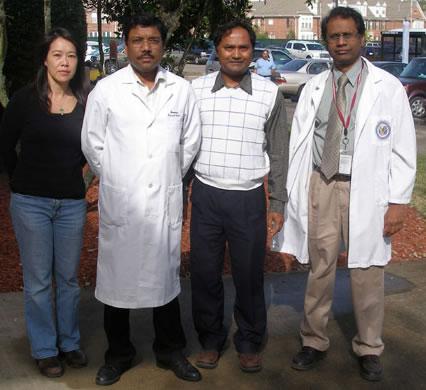About the Lab

The major emphasis of the Thiagarajan Lab is to elucidate the mechanism of the hypercoagulable state associated with the presence of antiphospholipid antibodies. Patients with systemic lupus erythematosus and allied autoimmune disorder have antibodies that react with anionic phospholipid such as cardiolipin in immunological assays.
Some of these antibodies also interfere with phospholipid-dependent coagulation tests and these inhibitors are called lupus anticoagulant. The immunological specificity of these antibodies is complex and it ranges from phospholipid binding proteins, a complex of phospholipid proteins and anionic phospholipid to anionic phospholipid alone. A number of phospholipid binding protein such as b 2 glycoprotein I, prothrombin, annexin V or oxidized LDL have been identified as an integral component of the complex epitope for these antibodies.
The clinical significance of these antibodies lies in the fact that their presence of is a strong risk factor for thrombosis: arterial, venous, microvascular and embolic. We have developed epitope libraries by phage-display from lymphocytes of patients with these antibodies and thrombosis. We are isolating recombinant scFv fragments to determine their epitope specificity. We utilize several in vitro coagulation assays and in vivo animal models of thrombosis to elucidate the mechanism of hypercoagulable state.
We are also exploring the cause and consequences of anionic phospholipid exposure in blood cells. Anionic phospholipids, such as phosphatidylserine, are normally present in the inner leaflet of membrane bilayer. Transbilayer movement of phosphatidylserine occurs during apoptosis, cellular senescence and during platelet activation. Exposure of phosphatidylserine in platelets is accompanied by the generation of platelet-derived microvesicles.
Microvesicles are also generated from other blood cells such as macrophages and endothelial cells during apoptosis and they are present in normal plasma. Deficiency of anionic phospholipid exposure and microvesiculation in platelets leads to an inherited bleeding disorder (Scot syndrome). Increased microvesicles have been detected in the circulation in patients with disseminated intravascular coagulation, heparin-induced thrombocytopenia, the antiphospholipid antibody syndrome, transient ischemic attacks, and thrombotic thrombocytopenic purpura, all conditions associated with either arterial or venous thrombosis. These associations suggest that, while they may be necessary for normal hemostasis, elevated microvesicles concentrations could predispose to thrombosis.
Clearly, a homeostatic mechanism must exist to balance the generation of anionic phospholipids by providing for their clearance, which when perturbed will enhance the risk of thrombosis. We are investigating defects in the clearance of microvesicles as a cause of hypercoagulable state.








